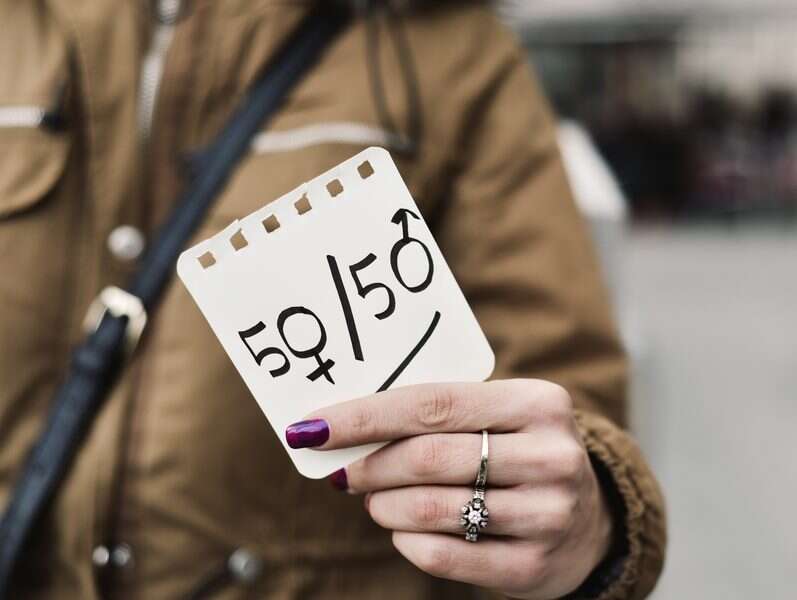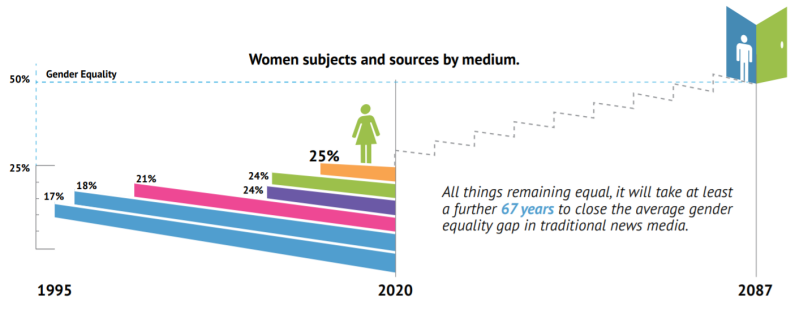
It will take at least another 67 years to close the worldwide gender equality gap in traditional news media, according to a new report analysing the proportion of women’s presence in the news.
There has however been an overall slight improvement in the number of stories in traditional news media (newspapers, TV and radio) that are reported by women, up from 37% in 2015 to 40%.
The Global Media Monitoring Project (GMMP) has been run by the World Association for Christian Communication (WAAC) every five years since 1995. In 2020, teams in 116 countries examined 30,172 newspaper, radio, TV and online stories.
WACC general secretary Philip Lee said the GMMP continues to show “that news paints a picture of a world in which women, in proportion to men, are dramatically under-represented and made invisible”. He said there had been only “small and slow” change since 1995.
In the past 20 years, women’s newspaper byline credits have increased by 11 percentage points and their visibility in newscasts has gone up by 9%.
The Gender Equality in the News Media index calculates the average gender equality gap based on these indicators: people in the news and subjects and sources, reporters, expert and spokesperson voices, and presence in economic and political news.
The report said the needle had edged "halfway to equality" thanks to "slight upward movement" on the proportion of women as sources and subjects, particularly in broadcast media.

Global Media Monitoring Project analysis shows gender equality gap in traditional news media will not close until 2087
In 2020 women made up 26% of subjects and sources in newspapers and television and 23% in radio. Twenty-five years earlier this was 21% in TV, 16% in papers and 15% in radio.
In the same period Africa is the only region not to have made any improvement. European news media have improved the most, up from 16% to 28%.
The only region and topic in which gender parity has been achieved in subjects and sources is in North American digital social and legal news.
The UK's gender equality gap is -45 (zero means 50/50 gender balance across all indicators, and -100 means only men are represented), worse than the US on -29.
Of the 116 countries analysed, the worst was Guyana with a score of -83 and the best was Nicaragua on -5.
The importance of having female journalists is emphasised by the fact that 31% of people they cover at traditional news outlets are women, compared to the 24% of subjects and sources used by male reporters. In online news, this gap widens slightly to 34% versus 25%.
The report’s analysis said: “Story quality from a gender perspective tends to be marginally higher in the output of women journalists, in terms of likelihood to clearly challenge gender stereotypes, to raise gender (in)equality issues and to make reference to legislation or policy that promotes gender equality or human rights”.
However overall news stories remain as unlikely to “clearly challenge gender stereotypes” as they were 15 years ago.
Between seven to nine out of ten stories on sexual harassment, rape, other forms of gender violence, and specific gender inequality issues “reinforce or do nothing to challenge gender stereotypes, with implications for the normalisation and continuance of the very injustices that are the focus of the stories”.
Women and girls are even “severely underrepresented” in stories about gender-based violence, especially in newspapers where they make up just 35% of subjects and sources for these topics. The report said this “signals a serious deficit in news media accountability to women”.
Transnational digital media have improved as platforms for women's voices since 2015 but “women’s invisibility remains even more marked in influential international media that serve formidable audiences,” the report said.
Digital news stories and tweets from Al Jazeera, BBC News World, CNN International, France 24, Reuters, RT News, TeleSur and the New York Times featured women as subjects and sources 21% of the time compared to 15% five years earlier. Performance was worse on international TV newscasts, where women were only 13% of subjects and sources.
'Dramatic' rise in expert female voices
Women have become more heard as experts and spokespeople following societal pressure and initiatives to boost their presence such as the BBC 50:50 project. A quarter (24%) of expert voices in the news are now women, a “dramatic” rise from 19% five years ago.
In stories about the Covid-19 pandemic, women were 27% of the doctors and health specialists that appeared, which the report said was “far fewer” than the 46% world average according to labour force statistics.
In the UK, London's City University has separately completed its latest Expert Women Project survey covering February to April this year. It said women experts in six UK flagship news programmes were back to 2019 levels after improvements "stalled".
March saw the best ratio ever recorded in the eight years the project has been running, with 1.6 men experts to every woman expert used, which was put down partly to the coverage around the murder of Sarah Everard in London and the subsequent vigil at Clapham Common.
In contrast, April saw the worst ratio recorded in four years, with 2.9 men experts to every woman expert used, which was put down to the European Super League football story which dominated the news cycle for several days.
The vigil story had 22 women experts and 12 men over two days on Channel 4 News, Breakfast on Sky News, ITV News at Ten, Today on BBC Radio 4, BBC News at Ten, and 5 News. The Super League story had 66 male experts and two women experts across three days.
Professor Lis Howell, who founded the project, said: “There seems to be some evidence that stories deemed to be of interest to men gain more airtime, and that men experts will be used more and for longer on stories of interest to men, than female experts on stories of interest to women. Sports stories of interest predominantly to men can still dominate the news agenda.
“There are some excellent women sports commentators but when it comes to the business of sport, men dominate.
“Overall, the pandemic has certainly led to a decrease in the use of women experts. This will surprise many people who believe that there are more women experts than there used to be.
“This perception is probably because there have been some recurring and highly visible women scientists and health workers.
“But the fact is, when compared to pre-pandemic 2020, women experts are not as plentiful, and when stories which appeal to men come along, they get a higher proportion of men experts than stories of interest to women get women experts.”
Picture: Shutterstock
Email pged@pressgazette.co.uk to point out mistakes, provide story tips or send in a letter for publication on our "Letters Page" blog
